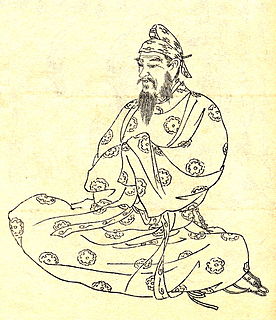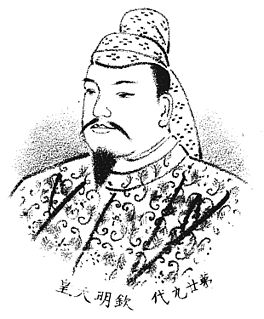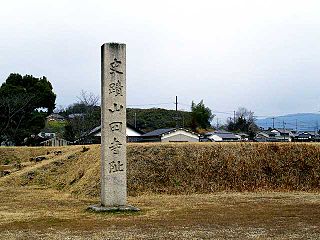 W
WAsuka-dera (飛鳥寺), also known as Hōkō-ji (法興寺), is a Buddhist temple in Asuka, Nara. Asuka-dera is regarded as one of the oldest temples in Japan.
 W
WFujiwara no Fuhito was a powerful member of the imperial court of Japan during the Asuka and Nara periods. Second son of Fujiwara no Kamatari, he had sons by two women, and those sons were the founders of the four principal lineages of the Fujiwara clan: the South, North, Ceremonial, and Capital lineages. Also, he had four daughters by two other women, three by Kamohime, one by Tachibana no Michiyo. One daughter by Kamohime became Emperor Monmu's wife Miyako, who in turn gave birth to Emperor Shōmu. The daughter by Michiyo became the empress of his grandson Shōmu, Empress Kōmyō.
 W
WFujiwara no Kamatari was a Japanese statesman, courtier and politician during the Asuka period (538–710). Kamatari was born to the Nakatomi clan and became the founder of the Fujiwara clan. He, along with the Mononobe clan, was a supporter of Shinto and fought the introduction of Buddhism to Japan. The Soga clan, defenders of Buddhism in the Asuka period, defeated Kamatari and the Mononobe clan and Buddhism became the dominant religion of the imperial court. Kamatari, along with Prince Naka no Ōe, later Emperor Tenji (626–672), launched the Taika Reform of 645, which centralized and strengthened the central government. Just before his death he received the honorific of Taishōkan and the surname Fujiwara from the Emperor Tenji, thus establishing the Fujiwara clan.
 W
WThe Historical Sites of Prince Shōtoku are a group of 28 Buddhist temples in Japan related to the life of Prince Shōtoku.
 W
WHōryū-ji is a Buddhist temple that was once one of the powerful Seven Great Temples, in Ikaruga, Nara Prefecture, Japan. Its full name is Hōryū Gakumonji (法隆学問寺), or Learning Temple of the Flourishing Law, the complex serving as both a seminary and monastery.
 W
WEmperor Kinmei was the 29th Emperor of Japan, according to the traditional order of succession.
 W
WMononobe no Moriya was an Ō-muraji, a high-ranking clan head position of the ancient Japanese Yamato state, having inherited the position from his father Mononobe no Okoshi. Like his father, he was a devoted opponent of Buddhism, which had recently been introduced to Japan from the mainland.
 W
WShitennō-ji is a Buddhist temple in Ōsaka, Japan. It is sometimes regarded as the first Buddhist and oldest officially administered temple in Japan, although the temple buildings have been rebuilt over the centuries. It is the head temple of the Wa Sect of Buddhism.
 W
WEmperor Shōmu was the 45th emperor of Japan, according to the traditional order of succession.
 W
WPrince Shōtoku , also known as Prince Umayado or Prince Kamitsumiya , was a semi-legendary regent and a politician of the Asuka period in Japan who served under Empress Suiko. He was the son of Emperor Yōmei and his consort, Princess Anahobe no Hashihito, who was also Yōmei's younger half-sister. His parents were relatives of the ruling Soga clan and also he was involved in the defeat of the rival Mononobe clan. The primary source of the life and accomplishments of Prince Shōtoku comes from the Nihon Shoki.
 W
WSoga no Umako was the son of Soga no Iname and a member of the powerful Soga clan of Japan.
 W
WEmperor Tenmu was the 40th emperor of Japan, according to the traditional order of succession.
 W
WTori Busshi was a Japanese sculptor active in the late 6th and early 7th century. He was from the Kuratsukuri clan, and his full title was Shiba no Kuratsukuri-be no Obito Tori Busshi (司馬鞍作部首止利仏師); Busshi is a title meaning "the maker of Buddhist images". By the early 7th century, Tori Busshi had become the favorite sculptor of Soga no Umako and Prince Shōtoku. Such high-ranking patrons indicate that Tori was highly esteemed as an artist and not just an anonymous craftsman. Many extant Asuka period sculptures in gilt bronze are credited to Tori and his workshop. The artist's work epitomizes Japanese sculpture during the era, with its solid, geometric figures in front-oriented, characteristic poses.
 W
WYamada-dera (山田寺) was a Buddhist temple established in the Asuka period in Sakurai, Nara Prefecture, Japan. The area has been designated a Special Historic Site and forms part of a grouping of sites submitted in 2007 for future inscription on the UNESCO World Heritage List: Asuka-Fujiwara: Archaeological sites of Japan’s Ancient Capitals and Related Properties. Excavations in the 1980s uncovered a well-preserved section of the temple's covered corridors that predate the surviving buildings of Hōryū-ji: "for the history of Japanese architecture, this discovery is of as great moment as the finding of the seventh-century Takamatsuzuka tomb paintings in March 1972 was for the history of Japanese art."
 W
WEmperor Yōmei was the 31st Emperor of Japan, according to the traditional order of succession.